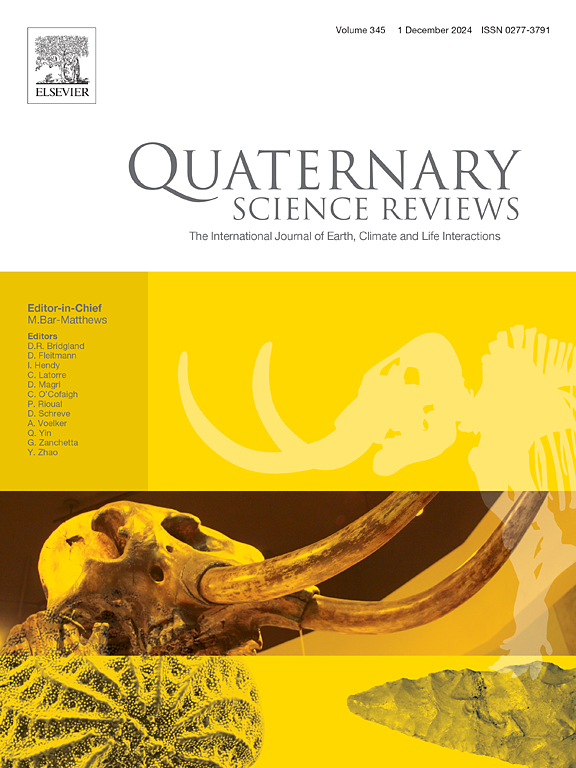The origin of the ice-free areas of the Hurd Peninsula (Livingston Island, Antarctica)
IF 3.2
1区 地球科学
Q1 GEOGRAPHY, PHYSICAL
引用次数: 0
Abstract
Spatio-temporal patterns of glacial retreat determine the intensity of geomorphological, hydrological, and ecological processes in the ice-free areas of the Antarctic Peninsula region. The chronology of glacial oscillations in the region following the Last Glacial Maximum (LGM) is still poorly constrained and mostly limited to data from a few sites adjacent to research stations. The Hurd Peninsula, located on Livingston Island (South Shetland Islands), is mainly covered by the Hurd Peninsula Ice Cap (HPIC); there is a ca. 20 km2 ice-free area downvalley of the ice cap in the peninsula's southern sector in addition to numerous nunataks that protrude above the HPIC. In this study, we present an approach combining two direct surface exposure dating methods, cosmic-ray exposure (CRE) dating and lichenometry, to reconstruct the spatio-temporal patterns of glacial thinning and ice cap retreat on the Hurd Peninsula. To understand the patterns of deglaciation on the peninsula, 26 samples for CRE dating (in situ cosmogenic 10Be) were taken from glacially polished surfaces and moraine boulders along a transect from the nunatak summits to the coast. On the most recent moraines, boulder stabilisation (i.e., indicative of glacier withdrawal) was dated through the longest axis of the 10 largest thalli of the lichen species Rhizocarpon geographicum. Ice thinning might have begun before the LGM at ca. 31.6 ka, when the highest areas close to the coast became exposed, and subsequently accelerated during the LGM at 20-18 ka. The upper surfaces were completely deglaciated between 16 and 14 ka. The HPIC was relatively stable until the mid-Holocene, when neoglacial advances of its outlet glaciers built moraines at ca. 4.5 ka. Subsequently, late Holocene polygenic moraines formed before the development of the external ridges of the most recent moraine system left by the HPIC outlets during the Little Ice Age, at 0.3 ka. The internal moraines correspond to glacial advances from the late 19th and early 20th centuries, as indicated by lichenometric dating. This work presents a comprehensive chronology of glacial oscillations on the Hurd Peninsula, enhancing our understanding of deglaciation patterns and offering insights into glacier dynamics due to climate variability and change.
赫德半岛(南极洲利文斯顿岛)无冰区的起源
冰川退缩的时空模式决定了南极半岛地区无冰区域的地貌、水文和生态过程的强度。该地区在末次冰川极盛期(LGM)之后的冰川振荡年代学研究仍很薄弱,而且大多仅限于研究站附近几个地点的数据。赫德半岛位于利文斯顿岛(南设德兰群岛)上,主要被赫德半岛冰盖(HPIC)覆盖;半岛南段冰盖下流有约 20 平方公里的无冰区,此外还有许多突出于赫德半岛冰盖之上的努纳塔克(nunataks)。在这项研究中,我们提出了一种结合两种直接地表暴露测年方法(宇宙射线暴露(CRE)测年法和地衣测量法)的方法,以重建赫德半岛冰川变薄和冰盖退缩的时空模式。为了了解半岛的冰川消融模式,研究人员从努纳塔克山顶到海岸的横断面上的冰川打磨表面和冰碛巨石上采集了 26 个样本进行宇宙射线暴露年代测定(原位宇宙成因 10Be)。在最近的冰碛上,通过地衣物种 Rhizocarpon geographicum 的 10 个最大叶柄的最长轴来测定巨石稳定(即表明冰川退出)的时间。冰层变薄可能始于距今约 31.6 ka 的全新世之前。31.6 ka,当时靠近海岸的最高区域开始裸露,随后在 20-18 ka 的全新世期间加速。上表面在 16 至 14 ka 期间完全冰川化。在全新世中期之前,HPIC 一直相对稳定,大约在 4.5 ka 时,其出口冰川的新冰川作用形成了冰碛。4.5 ka.随后,全新世晚期的多源冰碛形成于小冰河时期(0.3 ka)HPIC 出口冰川留下的最新冰碛系统外部山脊形成之前。地衣测年显示,内部冰碛与 19 世纪晚期和 20 世纪早期的冰川作用相对应。这项研究提供了赫德半岛冰川振荡的综合年表,加深了我们对冰川脱落模式的理解,并为我们深入了解气候多变性和气候变化引起的冰川动力学提供了依据。
本文章由计算机程序翻译,如有差异,请以英文原文为准。
求助全文
约1分钟内获得全文
求助全文
来源期刊

Quaternary Science Reviews
地学-地球科学综合
CiteScore
7.50
自引率
15.00%
发文量
388
审稿时长
3 months
期刊介绍:
Quaternary Science Reviews caters for all aspects of Quaternary science, and includes, for example, geology, geomorphology, geography, archaeology, soil science, palaeobotany, palaeontology, palaeoclimatology and the full range of applicable dating methods. The dividing line between what constitutes the review paper and one which contains new original data is not easy to establish, so QSR also publishes papers with new data especially if these perform a review function. All the Quaternary sciences are changing rapidly and subject to re-evaluation as the pace of discovery quickens; thus the diverse but comprehensive role of Quaternary Science Reviews keeps readers abreast of the wider issues relating to new developments in the field.
 求助内容:
求助内容: 应助结果提醒方式:
应助结果提醒方式:


